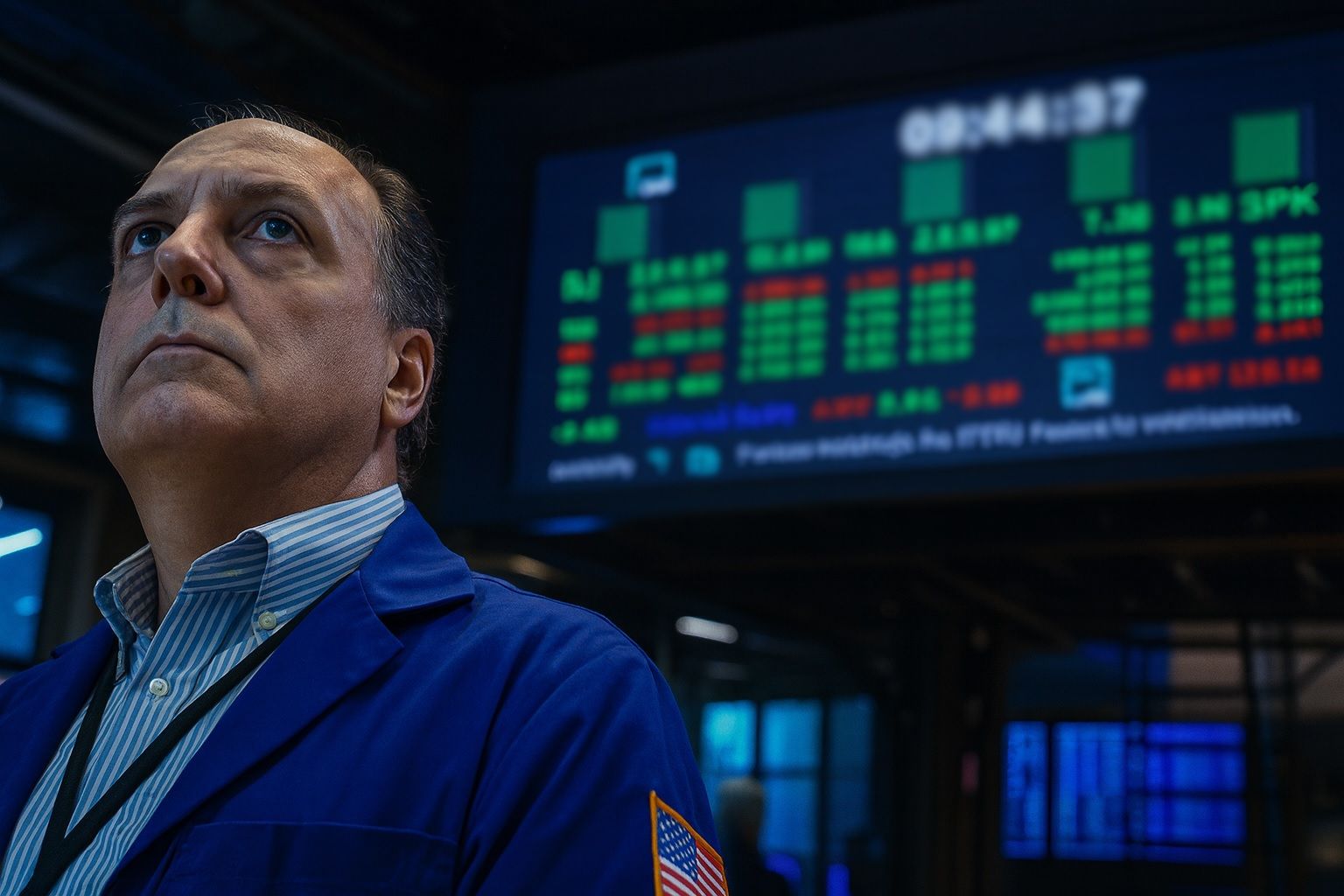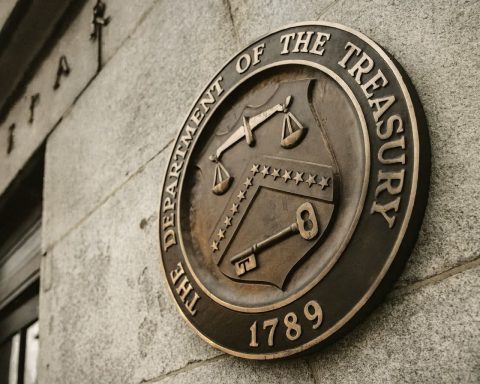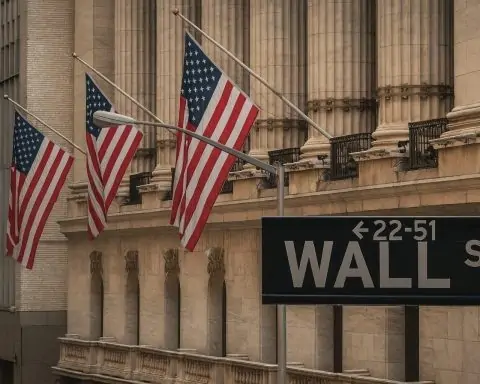- Safe-Haven Bond Surge: The benchmark U.S. 10-year Treasury yield sank to about 3.97%, dipping below 4% for the first time in 2025 [1]. Investors piled into bonds amid escalating U.S.–China trade war tensions and surprise banking fraud scandals, seeking safety from the market turmoil [2] [3]. This rush into Treasuries drove yields to their lowest levels of the year.
- Fed Signals Rate Cuts:Federal Reserve officials have struck a notably dovish tone, further fueling the bond rally. Fed Governor Michelle Bowman said she still expects “two more cuts” in interest rates this year [4], boosting bets that the Fed will ease policy sooner. Futures markets are now fully pricing in a rate cut at the Fed’s Oct. 28–29 meeting, on the heels of Chair Jerome Powell’s recent hints of a policy pivot [5].
- Stocks Whipsaw on Fears: Stock markets reversed course after mid-week gains. Earlier in the week, the S&P 500 and Nasdaq notched record highs on strong earnings, but by Thursday the rally unraveled. The Dow Jones Industrial Average fell almost 400 points and the S&P 500 lost nearly 1% on Oct. 16 as credit fears and trade angst hit sentiment [6]. Globally, Japan’s Nikkei slumped 1.6% and Hong Kong’s Hang Seng 2% on the news, while Europe’s bank stocks shed ~2.7% [7].
- Gold Hits Record High:Gold prices exploded to all-time highs amid the flight to safety, vaulting above $4,378 per ounce [8]. The precious metal surged roughly 8% this week – its largest weekly gain since 2008 – as jittery investors sought refuge in hard assets. Other havens outshone riskier bets: the U.S. dollar softened on Fed easing expectations, while even Bitcoin slid over 2% during the broad “risk-off” move [9].
- Outlook – Caution vs. Optimism: Analysts are divided on what comes next. Some warn the recent shocks could trigger another 5–10% market correction as investors digest credit troubles [10], and note that stubborn inflation and deficits may keep long-term yields from falling much further [11]. Yet many experts remain optimistic. Wharton professor Jeremy Siegel argues that as inflation cools, the Fed can “gently lower rates and extend the expansion” [12]. Indeed, some Wall Street strategists now project the S&P 500 could approach 7,000 by 2026 under a dovish Fed and resilient earnings growth [13].
Bond Yields Plunge Below 4% in Flight to Safety
A wave of safe-haven buying is sweeping through the bond market. The 10-year Treasury yield – a key benchmark for borrowing costs – dropped below 4% for the first time all year [14], a dramatic turnaround that underscores investors’ frayed nerves. This bond rally, which pushed the 10-year yield down to ~3.97%, signals an extraordinary flight to safety. According to AMP chief economist Dr. Shane Oliver, U.S. “bond yields fell” as investors flocked to havens due to “safe haven demand and increased expectations for US rate cuts” [15].
Multiple forces converged to drive this rush into Treasuries. Foremost is the renewed U.S.–China trade war flare-up that has markets on edge. Late last week, President Trump stunned observers by threatening 100% tariffs on Chinese imports starting Nov. 1, prompting Beijing to retaliate with export curbs [16]. “We still have a hangover from the [trade war]…both sides are digging their heels in,” warned Ron Albahary, chief investment officer at LNW in Philadelphia [17]. Investors increasingly fear that a “more intense trade war” could hurt the global economy [18], sending them scrambling into U.S. Treasuries as a safe haven. In fact, when these tariff threats first hit, bond strategists noted that Treasuries “benefit from…flight-to-safety bids” – 10-year yields briefly dipped near 4.0% on the initial news [19]. “The drop in equities and commodities is a clear sign of risk aversion… Money is instead moving into sovereign bonds,” observed Kathy Brooks of XTB, as the trade conflict intensified [20].
At the same time, an unexpected banking scare intensified the rush to safety. This week, two U.S. regional lenders revealed major loan frauds that rattled the financial sector. Zions Bancorp disclosed a surprise $50 million loan loss tied to alleged fraud, sending its stock plunging ~13% in a day [21]. Western Alliance Bancorp, which had exposure to the same borrower, fell 11% after admitting it quietly filed a fraud lawsuit in August [22]. These back-to-back shocks wiped out over $100 billion in U.S. bank stock value as contagion fears spread [23]. Even banks with no direct link sold off, dragging down major indexes. “When you see one cockroach, there are probably more,” JPMorgan CEO Jamie Dimon cautioned, after his bank took a $170 million hit on an unrelated bad loan [24]. Analysts note a string of recent “one-off” loan blowups has put markets on edge. “It shows you can’t take credit quality for granted, and poor credit at one bank can drag down the group fast,” said Stephen Biggar of Argus Research [25]. Faced with such surprises, “investors are selling first and asking questions later,” JPMorgan analysts wrote, questioning how many more “cockroaches” might be lurking in the financial system [26].
The twin fears of a trade war escalation and credit troubles created a perfect storm for bonds. Nervous investors essentially hit the eject button on riskier assets and poured into Treasuries, driving prices up and yields down. By Thursday Oct. 16, the 10-year yield had cratered to 3.97%, its lowest level of 2025 [27]. Short-term yields fell even more: the 2-year Treasury dropped to ~3.38%, a three-year low [28], reflecting rising bets that the Fed will cut rates to stabilize the economy. “Bond prices jumped” as these safe-haven flows accelerated, noted one market watcher, and the 10-year yield’s slide under 4% marked a striking shift from just a few weeks prior [29].
Stocks Slide as Gold Soars on Haven Demand
The sudden yield plunge came hand-in-hand with a sharp reversal in stocks. Earlier in the week, equity markets had been riding high – the S&P 500 and Nasdaq even set fresh all-time highs mid-week amid upbeat Q3 earnings from big banks and tech firms [30]. But by Thursday, sentiment flipped as the bank fraud news and trade tensions hit. All three major U.S. indexes sank into the red on Oct. 16. The Dow lost ~400 points (about 1.1%), wiping out its early-week gains [31]. The S&P 500 slid nearly 1%, and the Nasdaq also turned lower, after being up solidly just a day before [32]. Financial stocks led the decline – the S&P’s banking sector fell roughly 2.8% on Thursday, the worst of any group [33], as the regional bank scare undermined what had been a decent earnings week for lenders. “Consumer-exposed assets were selling off,” noted Matt Stucky of Northwestern Mutual, pointing to big drops in bank and credit card stocks on fears of tighter credit ahead [34]. In contrast, tech shares held up relatively better – the sector was the sole gainer in the S&P – buoyed by the prospect of lower interest rates (which make high-growth tech valuations more attractive) [35] [36].
The market jitters weren’t confined to the U.S. Global stocks echoed the turmoil. In Asia, Japan’s Nikkei index fell 1.6% on Friday and Hong Kong’s Hang Seng dropped 2% [37] as investors there reacted to the U.S. volatility and trade war headlines. European markets also slipped; bank stocks across the Eurozone sank about 2.7% amid the broader credit scare [38]. London’s FTSE 100 gave up 1.5% at the open Friday as the risk-off mood spread [39].
Amid the equity selloff, classic safe-haven assets surged in a mirror-image response. Chief among them, gold has been on a tear. The price of gold blasted to a record high, breaking above $4,378 per ounce for the first time ever [40]. It’s up roughly 8% this week alone, marking gold’s largest weekly gain since 2008’s crisis [41]. This astonishing rally reflects investors snapping up the precious metal as a store of value in uncertain times. “Gold continued its surge…on safe haven demand in the face of the ongoing U.S./China tensions,” observed Dr. Oliver of AMP, noting the metal’s rise has been aided by falling interest rates and a weaker dollar [42]. Notably, silver also hit a record high alongside gold [43].
Other corners of the market underscore the flight-to-safety dynamic. The U.S. dollar, which typically gains in times of stress, actually softened a bit this week as traders anticipated Fed rate cuts (which make the dollar less attractive) [44]. Meanwhile, cryptocurrencies—often dubbed “digital gold”—did not serve as a safe haven: Bitcoin prices actually fell over 2% amid the market volatility [45], highlighting that in this cycle crypto is trading more like a risk asset correlated with stocks. As one strategist noted, Bitcoin’s slide “reflect[s] ‘risk off’ sentiment, highlighting that it’s become increasingly correlated with shares in a high beta fashion” [46]. In contrast, traditional havens shined: besides gold’s record, Treasury bonds of course rallied (with prices up and yields down), and even the Japanese yen and Swiss franc saw gains as global investors sought low-risk parking spots [47].
Fed Hints at Easing – Policy Pivot in Play
Another crucial factor behind the bond rally is growing confidence that the Federal Reserve will step in to support the economy. Over the past week, Fed officials have given their clearest signals yet that interest-rate cuts are on the way – a stark shift from the tightening cycle of previous years. In a high-profile speech on Oct. 14, Fed Chair Jerome Powell struck an unmistakably dovish tone. He emphasized the Fed would proceed “meeting-by-meeting” in assessing policy moves and noted the central bank could even halt its quantitative tightening (bond portfolio runoff) sooner than expected [48] [49]. Powell’s message reassured markets that the Fed is prepared to pivot to easing if conditions warrant. In fact, Powell “dropped a major piece of news” by hinting at ending balance sheet reduction – a “hidden source of relief” that immediately bolstered bond market sentiment, observed analyst Callie Cox [50]. Yields, which were already sliding on trade fears, fell further as traders digested Powell’s remarks.
Fed officials across the board are now voicing more accomodative views. Philadelphia Fed President Anna Paulson called two additional rate cuts “appropriate” to ensure the economy’s momentum isn’t derailed [51]. And Fed Governor Michelle Bowman explicitly said this week she expects two more rate cuts by the end of 2025 [52], underscoring the central bank’s bias toward easing. These comments align with market expectations: futures pricing shows traders are fully betting on a Fed rate cut at the upcoming Oct. 28–29 FOMC meeting, and likely another by December [53]. The bond market’s reaction has been dramatic – short-term yields like the 2-year Treasury have collapsed to multi-year lows on the prospect of Fed rate relief [54].
Economic underpinnings support the Fed’s cautious stance. Inflation, while still above target, has been easing toward ~3%, and the labor market has shown signs of cooling (job growth has slowed from its peak pace). A Reuters Fed watcher noted that policymakers see room to lower rates as long as the data keep softening: “as long as we see the labor market and other data evolving…we will continue to be on a path for lowering the federal funds rate,” this observer said of the Fed’s mindset [55]. In other words, the central bank appears ready to trim rates to cushion the economy, especially with new risks like the trade war and credit issues on the horizon.
The anticipation of Fed support is part of why the bond rally has accelerated. With the Fed potentially cutting rates and even stopping balance-sheet tightening, the backdrop for bonds has turned very bullish. The yield curve has steepened as short-term rates fall faster than long-term rates – a typical pattern when markets expect easier Fed policy [56]. The 2-year yield (sensitive to Fed moves) is now far below the 10-year yield, after a long period of inversion, signaling that investors think the Fed will aggressively ease in the near term. Some Fed insiders have even hinted that balance-sheet tools could be adjusted if needed to ensure market liquidity, a notable development after years of quantitative tightening.
Outlook: Will the Rally Last?
With bonds surging and stocks stumbling, what comes next for markets is hotly debated. On one side, caution abounds. Market veterans point out that the current climate has many potential pitfalls – and that the recent flight to safety might not abate quickly. “The risk of a correction remains high,” warned Dr. Oliver, given stretched valuations and multiple triggers for volatility still in play [57]. Some strategists note that the S&P 500 already rallied nearly 20%+ this year before October, so any shock (like trade war escalations or earnings disappointments) could spark a 5–10% pullback from the highs [58]. Indeed, the past two weeks have delivered a reminder of that fragility: a sudden tariff flare-up and a couple of bank frauds were enough to knock the wind out of a strong market.
Bond market experts also urge realism about how low yields can sustainably go. “We don’t expect long-term yields to fall much further, if at all,” said Collin Martin, fixed income director at Charles Schwab [59]. He argues that even with Fed rate cuts coming, sticky inflation and the U.S. government’s large deficits will likely keep the 10-year yield hovering around or above 4% [60]. In other words, there is a floor under yields – borrowing costs may not have much more room to decline unless the economy deteriorates significantly. A mid-October Reuters poll of strategists seems to back this up: the consensus expects the 10-year yield to be roughly 4.1% in six months (not far from where it was before this latest scare) [61]. The implication is that the current sub-4% dip could be short-lived unless the Fed delivers larger-than-expected rate cuts or a major recession looms.
On the other side of the debate, optimists see a soft landing and even more upside for stocks once these hiccups pass. Jeremy Siegel, professor emeritus at Wharton, contends that as long as inflation continues to cool, the Fed can “gently lower rates and extend the expansion” without crushing growth [62]. In his view, the October volatility is a speed bump, and Fed easing alongside solid corporate earnings could prolong the bull market well into 2026. Many on Wall Street share this bullish outlook. RBC Capital Markets, for example, recently raised its S&P 500 targets – now forecasting the index around 6,250 by the end of 2025 and potentially ~7,100 by 2026 [63]. Goldman Sachs likewise bumped its year-end S&P target to ~6,800 [64]. These banks cite the combo of a “dovish Fed and resilient earnings” as a recipe for further equity gains ahead [65]. In this scenario, the current bond yield plunge actually bolsters stocks (especially growth stocks) by reducing interest rates and boosting liquidity. In short, bulls argue the market can have its cake and eat it too: lower rates containing borrowing costs while the economy avoids a deep slump.
Who will be right? Risks clearly remain. Even as the Fed pivots, other headwinds could emerge – for instance, the Bank of England has warned that U.S. tech stock valuations look “excessively high” and could be vulnerable to a sharp correction [66]. And Bank of America strategists note that with fiscal uncertainty (huge U.S. debt and potential government shutdowns) and trade conflicts simmering, there is “no risk-free path” for investors in 2025 [67]. Any misstep on policy or a geopolitical surprise could jolt both stocks and bonds in unpredictable ways.
For now, markets are adopting a bit of a hedged stance. Some analysts dub it a “flight and fight” approach [68] – investors are hedging their bets by holding onto both risk assets and safe havens simultaneously. Indeed, even as the S&P 500 hovers near historic highs, demand for gold and Treasuries is spiking, reflecting a mix of fear and optimism. “The bulls remain fully in charge,” one strategist quipped recently, “but they’re also buying insurance” [69].
Bottom line: The drop in the 10-year yield below 4% is a watershed moment for 2025’s markets, signaling that anxiety has finally overtaken the once-euphoric rally – at least for now. Whether this marks the start of a lasting downtrend in yields (and a more significant shift in market regime) or just a temporary blip will depend on how the Fed responds and whether trade and credit fears persist. Investors will be closely watching the coming Fed meeting and incoming data. If the Fed delivers the expected rate cut and trade tensions ease, confidence could return – potentially pushing yields back above 4% and reigniting the stock rally. If, however, more surprises lurk (be it inflation, geopolitics, or financial landmines), the current flight to safety may only intensify. In this high-wire market, it’s clear that volatility is back. Investors are bracing for a bumpy ride, even as they hope that a Fed-powered soft landing will ultimately keep the decade-long bull market on track [70].
Sources: Recent market data and commentary from The Wall Street Journal, Barron’s, CNBC and TS² TechStock² news [71] [72] [73] [74], plus analysis from Reuters, Bloomberg, and expert insights [75] [76]. All information is current as of Oct. 17, 2025.
References
1. ts2.tech, 2. ts2.tech, 3. www.tradingview.com, 4. ts2.tech, 5. ts2.tech, 6. ts2.tech, 7. ts2.tech, 8. ts2.tech, 9. www.tradingview.com, 10. ts2.tech, 11. ts2.tech, 12. ts2.tech, 13. ts2.tech, 14. ts2.tech, 15. www.amp.com.au, 16. www.tradingview.com, 17. www.tradingview.com, 18. www.tradingview.com, 19. ts2.tech, 20. ts2.tech, 21. ts2.tech, 22. ts2.tech, 23. ts2.tech, 24. ts2.tech, 25. ts2.tech, 26. ts2.tech, 27. ts2.tech, 28. ts2.tech, 29. ts2.tech, 30. ts2.tech, 31. ts2.tech, 32. ts2.tech, 33. www.tradingview.com, 34. www.tradingview.com, 35. www.tradingview.com, 36. www.tradingview.com, 37. ts2.tech, 38. ts2.tech, 39. ts2.tech, 40. ts2.tech, 41. ts2.tech, 42. www.amp.com.au, 43. www.amp.com.au, 44. www.amp.com.au, 45. www.tradingview.com, 46. www.amp.com.au, 47. www.reuters.com, 48. ts2.tech, 49. ts2.tech, 50. ts2.tech, 51. ts2.tech, 52. ts2.tech, 53. ts2.tech, 54. ts2.tech, 55. ts2.tech, 56. ts2.tech, 57. www.amp.com.au, 58. ts2.tech, 59. ts2.tech, 60. ts2.tech, 61. ts2.tech, 62. ts2.tech, 63. ts2.tech, 64. ts2.tech, 65. ts2.tech, 66. ts2.tech, 67. ts2.tech, 68. ts2.tech, 69. ts2.tech, 70. ts2.tech, 71. ts2.tech, 72. www.tradingview.com, 73. ts2.tech, 74. ts2.tech, 75. www.amp.com.au, 76. ts2.tech










